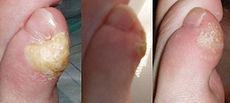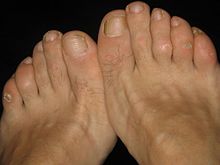- Callus
-
This article is about calluses and corns of human skin. For other uses, see Callus (disambiguation).
Callus Classification and external resources 
Examples of callus found on the toeICD-10 L84 ICD-9 700 MeSH D002145 A callus (or callosity) is an especially toughened area of skin which has become relatively thick and hard in response to repeated friction, pressure, or other irritation. Rubbing that is too frequent or forceful will cause blisters rather than allow calluses to form. Since repeated contact is required, calluses are most often found on feet because of frequent walking. Calluses are generally not harmful, but may sometimes lead to other problems, such as skin ulceration or infection.
Contents
Cause
Normally, a callus will form on any part of the skin exposed to friction over a long period of time. For example, people often develop calluses on the middle finger of their dominant hand due to writing with a pen or pencil. Another cause is from playing string instruments like the violin or the guitar; calluses will develop on the four left hand fingers used in holding the strings down to the fingerboard, and sometimes right hand fingers used for pizzicato or strumming. Calluses are also very common on the fingers of bassists who use both the pizzicato and slapping techniques. There are many activities that can result in the formation of a callus, and having one is sometimes viewed as a badge of honor.[1] Activities that are notorious for causing calluses include (but are not limited to) playing musical instruments, martial arts, many sports (specifically racket sports), weight training, dancing (especially ballet), digging, chopping wood, and wearing high heels. Tenpin bowlers will often develop calluses on their thumbs and occasionally their middle fingers from frequent bowling.[2] Although often found on the foot (where the most pressure and friction are applied), calluses can occur anywhere on the body as a reaction to moderate, constant "grinding" pressure. It is the natural reaction of the palmar or plantar skin. Too much friction occurring too fast for the skin to develop a protective callus will cause a blister or abrasion instead.
Biologically, calluses are formed by the accumulation of terminally differentiated keratinocytes in the outermost layer of skin. Though the cells of calluses are dead, they are quite resistant to mechanical and chemical insults due to extensive networks of cross-linked proteins and hydrophobic keratin intermediate filaments containing many disulfide bonds.[3]
Sometimes a callus occurs where there is no rubbing or pressure. These hyperkeratoses can have a variety of causes. Some toxins, such as arsenic, can cause thick palms and soles. Some diseases, such as syphilis, can cause thickening of the palms and soles as well as pinpoint hyperkeratoses. There is a benign condition called keratosis palmaris et plantaris, which produces corns in the creases of the fingers and non-weight bearing spaces of the feet. Some of this may be caused by actinic keratosis, which occurs due to overexposure to sun or with age and hormonal shifts.
Corns
Main article: Corn (medicine)A corn (or clavus, plural clavi) is a specially-shaped callus of dead skin that usually occurs on thin or glabrous (hairless and smooth) skin surfaces, especially on the dorsal surface of toes or fingers. They can sometimes occur on the thicker palmar or plantar skin surfaces. Corns form when the pressure point against the skin traces an elliptical or semi-elliptical path during the rubbing motion, the center of which is at the point of pressure, gradually widening. If there is constant stimulation of the tissue producing the corns, even after the corn is surgically removed, the skin may continue to grow as a corn.[citation needed]
The hard part at the center of the corn resembles a funnel with a broad raised top and a pointed bottom. Because of their shape, corns intensify the pressure at the tip and can cause deep tissue damage and ulceration.[4] The scientific name for a corn is heloma (plural helomata). A hard corn is called a heloma durum, while a soft corn is called a heloma molle.
The location of soft corns tends to differ from that of hard corns. Hard corns occur on dry, flat surfaces of skin. Soft corns (frequently found between adjacent toes) stay moist, keeping the surrounding skin soft. The corn's center is not soft however, but indurated.
The specific diagnostic workup and treatments for corns may differ substantially from other forms of calluses
Prevention
Corns and calluses are easier to prevent than to treat. When it is not desirable to form a callus, minimizing rubbing and pressure will prevent callus formation. Footwear should be properly fitted,[5] gloves may be worn, and protective pads, rings or skin dressings may be used. People with poor circulation or sensation should check their skin often for signs of rubbing and irritation so they can minimize any damage.
Treatment
Calluses and corns may go away by themselves eventually, once the irritation is consistently avoided. They may also be dissolved with keratolytic agents containing salicylic acid, sanded down with a pumice stone or filed down with a callus shaver, or pared down by a professional such as a podiatrist or a foot health practitioner.[6]
Before 1937 (when commerce in medicinal cannabis was effectively banned by a federal law in the United States), topical corn remedies usually contained tincture of cannabis, whose antibacterial properties were an effective agent. In addition, the inclusion of cannabis provided the herbal green appearance expected by consumers of the day.[7]
Diabetes
People with diabetes face special skin challenges. Because diabetes affects the capillaries, the small blood vessels which feed the skin, thickening of the skin with callus increases the difficulty of supplying nutrients to the skin.[citation needed] Callus formation is seen in high numbers of patients with diabetes and together with absent foot pulses and formation of hammer toe,[8][9] this may be an early signs of individuals at an increased risk for foot ulcers.[8]
The stiffness of a callus or corn, coupled with the shear and pressure that caused it, may tear the capillaries or adjoining tissue, causing bleeding within the callus or corn. Often, bleeding within a callus is an early sign of diabetes, even before elevated blood sugars may be noticed. Although the bleeding can be small, sometimes small pools of blood or hematoma are formed. The blood itself is an irritant, a foreign body within the callus that makes the area burn or itch. If the pool of blood is exposed to the outside, infection may follow. Infection may also lead to ulceration. Luckily, this process can be prevented at several places, Diabetic foot infections are the leading cause of diabetic limb amputation.
Other meanings
In botany, the term is also used to describe a condition of thickened surfaces of leaves or other plant parts. A callus also can refer to an undifferentiated plant cell mass grown on a culture medium, which can be put into a bioreactor to produce genetically identical cells.
See also
Notes
- Taber's Cyclopedic Medical Dictionary, 15th Edition, CL Thomas, M.D., M.P.H., editor, F.A. Davis Company, Philadelphia, PA, 1985.
- The Merck Manual of Medical Information, Home Edition, R Berkow, M.D., et al., editors, Merck Research Laboratories, Whitehouse Station, NJ, 1997.
References
- ^ "Google Search". http://www.google.com/search?q=proud+calluses.
- ^ "Google Search". http://www.tititudorancea.com/z/callus.htm.
- ^ Tantisiriwat N, Janchai S (Dec 1991). "Transglutaminases: multifunctional cross-linking enzymes that stabilize tissues.". The FASEB Journal 5 (15): 3071–7. PMID 1683845. http://www.fasebj.org/content/5/15/3071.long.
- ^ eMedicine > Clavus By Nanette Silverberg. Updated: Apr 9, 2010
- ^ Erstad, Shannon (6 March 2008). "Foot problems: Finding the right shoes". WebMD Medical Reference from Healthwise. Healthwise. "How do I find the right shoes?". http://www.webmd.com/a-to-z-guides/finding-the-right-footwear-for-your-foot-problem. Retrieved 2010-06-10. "You should not have to "break in" shoes if they fit properly."
- ^ Corns and calluses: Treatments and drugs. Mayo Clinic. Retrieved July 23, 2009.
- ^ http://antiquecannabisbook.com/chap6/CornMed.htm
- ^ a b Alavi A, Sanjari M, Haghdoost A, Sibbald RG (April 2009). "Common foot examination features of 247 Iranian patients with diabetes". Int Wound J 6 (2): 117–22. doi:10.1111/j.1742-481X.2009.00583.x. PMID 19432661. -12% having callus formation
- ^ Tantisiriwat N, Janchai S (July 2008). "Common foot problems in diabetic foot clinic". J Med Assoc Thai 91 (7): 1097–101. PMID 18839852. -56% having callus present
External links
For a definition of the word "callous", see the Wiktionary entry callous.Cutaneous keratosis, ulcer, atrophy, and necrobiosis (L82–L94, 700–701.5) Epidermal thickening keratoderma: Keratoderma climactericum • Paraneoplastic keratoderma (Acrokeratosis paraneoplastica of Bazex ) • Aquagenic keratoderma · Drug-induced keratoderma · Paraneoplastic keratoderma • psoriasis (Keratoderma blennorrhagica)
keratosis: Seborrheic keratosis (Clonal seborrheic keratosis · Common seborrheic keratosis · Irritated seborrheic keratosis · Seborrheic keratosis with squamous atypia · Reticulated seborrheic keratosis · Dermatosis papulosa nigra) • Keratosis punctata of the palmar creases
other hyperkeratosis: Acanthosis nigricans (Confluent and reticulated papillomatosis) · Callus • Ichthyosis acquisita · Arsenical keratosis · Chronic scar keratosis · Hyperkeratosis lenticularis perstans · Hydrocarbon keratosis · Hyperkeratosis of the nipple and areola · Inverted follicular keratosis · Lichenoid keratosis · Multiple minute digitate hyperkeratosis · PUVA keratosis · Reactional keratosis · Stucco keratosis · Thermal keratosis · Viral keratosis · Warty dyskeratoma · Waxy keratosis of childhood
other hypertrophy: Keloid · Hypertrophic scar • Cutis verticis gyrata ·Necrobiosis/granuloma Granuloma annulare (Perforating, Generalized, Subcutaneous, Granuloma annulare in HIV disease, Localized granuloma annulare, Patch-type granuloma annulare) · Necrobiosis lipoidica · Annular elastolytic giant cell granuloma · Granuloma multiforme · Necrobiotic xanthogranuloma · Palisaded neutrophilic and granulomatous dermatitis · Rheumatoid nodulosis · Interstitial granulomatous dermatitis/Interstitial granulomatous drug reactionForeign body granulomaBeryllium granuloma • Mercury granuloma • Silica granuloma • Silicone granuloma • Zirconium granuloma • Soot tattoo • Tattoo • Carbon stainOther/ungroupedeosinophilic dermatosis (Granuloma faciale)Dermis/
localized CTDCutaneous lupus
erythematosusLocalized scleroderma (Localized morphea, Morphea–lichen sclerosus et atrophicus overlap, Generalized morphea, Atrophoderma of Pasini and Pierini, Pansclerotic morphea, Morphea profunda, Linear scleroderma)Atrophic/
atrophodermaLichen sclerosus · Anetoderma (Schweninger–Buzzi anetoderma, Jadassohn–Pellizzari anetoderma) · Atrophoderma of Pasini and Pierini · Acrodermatitis chronica atrophicans · Semicircular lipoatrophy · Follicular atrophoderma · Linear atrophoderma of MoulinKyrle disease · Reactive perforating collagenosis · Elastosis perforans serpiginosa · Perforating folliculitis · Acquired perforating dermatosisOtherCategories:- Foot diseases
- Skin conditions resulting from physical factors
Wikimedia Foundation. 2010.

